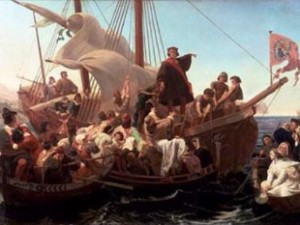Utopias?

Shangri-La and El Dorado: hoped-for earthly utopias, searched for but never quite found. Last month offered glimpses of the real stories of both, through the debut of the restored version of John Noel’s 1924 film The Epic of Everest and the British Museum’s exhibition Beyond El Dorado. Though separated by almost 400 years, the searches had similarities.
The myth of Shangri-La was set out in James Hilton’s 1933 novel Lost Horizon. Its origins might well be in the early attempts on Everest, which sparked a rash of popular travel books as well as Noel’s two remarkable films of the 1922 and 1924 expeditions. Noel centres the myth on the Shining Crystal Monastery in Shegar, where the climbers halted en route. Noel had been strongly impressed by the monastery’s beauty and dramatic location when he first saw it in 1922, but according to Wade Davis it was the first expedition’s leader, Charles Howard-Bury, who saw it as the pinnacle of his ‘spiritual seeking’, having had no previous knowledge of its existence despite his familiarity with Tibetan culture.
Other climbers such as George Mallory were more prosaic: Tibet was ‘a hateful country inhabited by hateful people’. However, the high level of interest in the film (which included the last shots of Mallory and Irvine before their dramatic disappearance) meant that a mystical presentation of Tibet prevailed. For the many who saw it on both sides of the Atlantic, the film offered their first impressions of Shangri-La itself, augmented by the lamas and musicians shipped over by Noel to enliven the screenings.
El Dorado was both Spanish America’s mythical ‘lost city of gold’ and the name given by the Spanish to the chief of the Muisca people, who was literally ‘the gold one’. The Muisca initiation ceremony for a new ruler was to cover his naked body in gold dust, and despatch him to the middle of the sacred LakeGuatavita, on a raft loaded with gold ornaments. Once in the centre of the lake, the chief would hurl the gold into the water as an offering to the god believed to live beneath it. The BritishMuseum’s show has a gold model of the raft as well as many of the exquisite ornaments made by the Muisca and other peoples skilled in gold artistry in what is now Colombia.
Needless to say, following the conquest, several attempts were made to find the Muisca gold, none very successful. The Spanish greed for the metal made them blind to the beauty of the objects themselves. Gold held no monetary value for the indigenous peoples, it was simply an exquisite material from which to create religious and other images. Some of the exhibition’s most striking pieces are the smallest: tiny gold jaguars and other sacred animals. The collection from which they come, the Museo de Oro in Bogota, must represent a small fraction of what the Spanish found, the rest having been melted into ingots.
What similarities are there between the stories of the two utopias? Both discoveries were marked by violence. After various attempts to penetrate mystical Tibet, British forces finally entered in 1904, were frustrated in their attempted passage to Lhasa and massacred more than six hundred soldiers armed only with swords who stood in the way. The search for El Dorado involved torture of ‘Indians’ thought to know the whereabouts of the gold, although Hugh Thomas says the first conquest of the region ‘brought almost as much tragedy to the conquerors as to the conquered’.
Both utopias were real places, with some of the characteristics attributed to them, although neither lived up to the more exaggerated expectations. Neither utopia had a precise location, however, the names Shangri-La and El Dorado being pinned on many other places apart from those noted here.
And in both cases the utopias were destroyed, or at least severely degraded, by the outsiders who encountered them. The indigenous peoples of Latin America are a tiny fraction of the numbers there when Columbus first arrived, and many of these are still under threat from plunder of gold and its modern equivalent, oil. The Shining Crystal Monastery was destroyed in the Cultural Revolution, and the destruction of Tibet’s traditions under Chinese occupation is well known. While both film and book remind us that the realities of Shangri-La and El Dorado were less than utopian, they also allow us to savour some of the explorers’ amazement when they first came upon them.